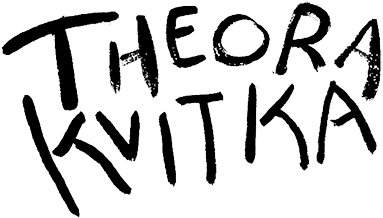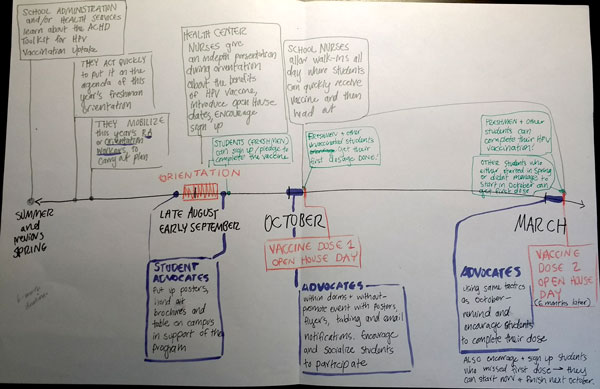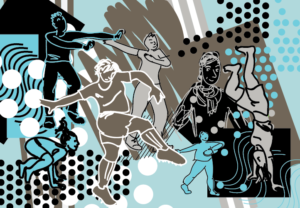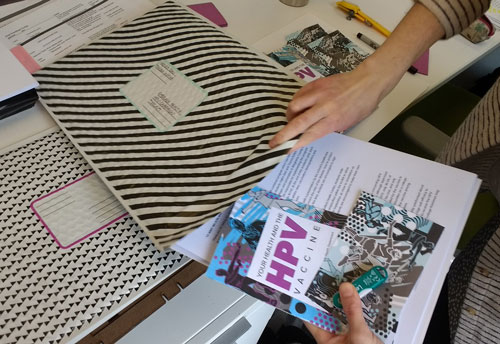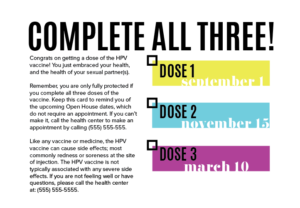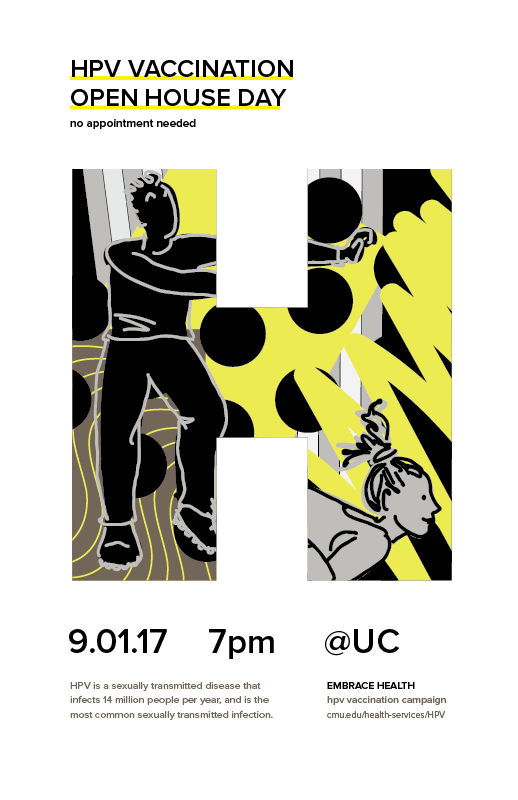
The Embrace Health HPV Campaign is a complete, self-contained program aiming to increase HPV Vaccination rates on college campuses. Hajira Qazi, a fellow graduate student, and I researched and designed this program as a part of our Visual Communications Studio at Carnegie Mellon University. Our client was the Allegheny County Health Department (ACHD), represented by Abby Wilson, the Deputy Director for Public Policy and Community Relations.
Research
Primary
As a part of understanding the problem of low HPV vaccination rates, Theora interviewed a pediatric nurse practitioner in Philadelphia, and a peer whose parents had refused to vaccinate her as a child (any/ all vaccines).
Hajira contacted and set up an in-person interview with Lisa Lonchar, RN, at Carnegie Mellon University Health Services. When we met with her and explained our ideas, she confirmed feasibility of using the Open House format and overall interest in such a program.
Secondary
Hajira and Theora both researched demographics and vaccination rates among college-age men and women, read studies which gauged awareness and receptivity to the vaccine, evidence of herd immunity, as well as reviews of HPV vaccine interventions and programs performed in college settings. A list of references is available as a PDF here.
Visual Research
In order to combine Theora and Hajira’s visual styles, we aimed for a visual style that was hand-drawn, a bit eclectic, and brightly colored. We collected inspiration for colors, page layouts, and visual styles on Pinterest to help formulate a visual concept. We also looked other marketing campaigns that target a similar demographic, such as MTV and Snapchat, for font and color inspiration.
Ideation
Age group
Through our research we knew that the cut-off age to receive the vaccine is 26 for women and 21 for men, and that many young adults in this age group were not vaccinated in the recommended 11-12 year old window. Additionally, at age 18, there is no parental consent required for vaccination, which lessens the potential for parental fear and opposition to uptake among this newly independent group. However, in this “catch up” group, the CDC recommends that men and women receive three doses of the vaccine rather than just two.
…at age 18, there is no parental consent required for vaccination, which lessens the potential for parental fear and opposition to uptake among this newly independent group.
Articles we found indicated that although college aged men and women are currently uninformed about the vaccine (Lambert, Hunter), they are very receptive to information and have high self-efficacy to complete the doses (Leitch). 18-year-old women are about four times as likely to receive the HPV vaccine compared with women aged 19–26 (Licht), so we decided to narrow the focus to college freshmen, who have ample time to complete the doses. Interventions on college campuses, especially those using peer-to-peer communication, have been shown to be effective in increasing uptake of the vaccine (Long, Daly, Ayala-Marin). A list of all references is available as a PDF here.
We did a brainstorming exercise with some other design graduate students to think about the ecosystem of social practices around Freshmen arriving on campus. 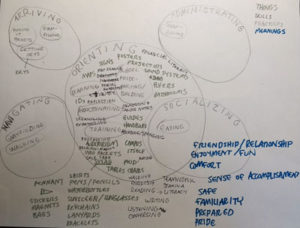
Scope
Based on this research and brainstorming, we decided to focus on college Freshman with a targeted campaign and toolkit to increase awareness of the risks of HPV and make it easier for students to begin and finish all three doses of the vaccine while on campus.
The Campaign begins with a presentation by college healthcare professionals from the Student Health Center. These informed and trustworthy people are already on campus and have a demonstrated interest in increasing health of students. The facilities of the Health Center provide an appropriate and familiar setting where the vaccine can be administered. Using a program of three open house days, students can walk in and receive all three doses of the vaccine.
Second, the campaign makes use of Student Advocates: upper classmen, RAs or student staff who will help with logistics and provide peer-to-peer encouragement and information.
…the campaign makes use of Student Advocates who will help with logistics and provide peer-to-peer encouragement and information.
Constraints
Awareness of budgets, both of the ACHD and individual colleges, helped us to narrow our project to low-cost, paper-based and in-person solutions. We wanted this program to be customizable for different schools and across multiple years, so it needed to be “evergreen”, flexible and low-tech. Time was another constraint. To make it easy for students, we wanted them to be able to get all three doses of the vaccine within one school year while they were present on campus.
First Prototypes
Drafts
In order to develop the correct tone for the written content, Theora completed a style guide for writing targeted towards college students.
The voice of the HPV toolkit materials is knowledgeable and authoritative, but still relateable and fun. We are interested in suggesting a “mother figure” to imply social permission for women interested in getting the vaccine, while refraining from excessive scientific jargon. A fun, health-conscious and sex-positive Aunt Jen.
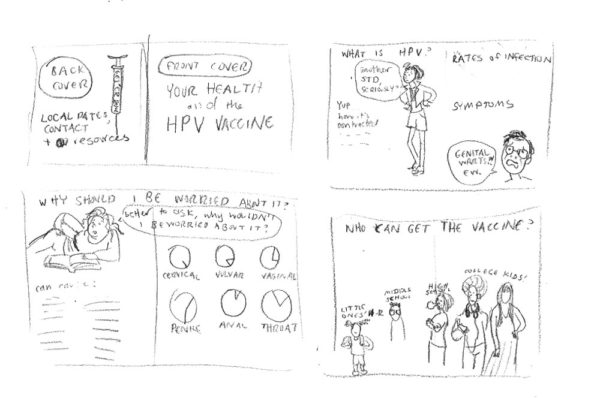 After doing research and pinning down the style, we set out drawing up initial drafts. We developed the idea of a pamphlet which would be given out to freshman as a primary resource about the virus, its consequences and the vaccine.
After doing research and pinning down the style, we set out drawing up initial drafts. We developed the idea of a pamphlet which would be given out to freshman as a primary resource about the virus, its consequences and the vaccine.
Theora wrote material for the pamphlets and drew a rough sketch of a possible layout. Hajira worked off of these mockups to develop a rough page layout, experimenting with fonts, colors, and visual styles.
Theora sketched out a timeline to help visualize when the program would take place and what stakeholders would be involved.
Feedback and Iteration
Feedback from Andrew Twigg and Abby Wilson emphasized setting the visual tone to ensure our materials appealed across genders, with particular attention to color choices that might be alienating to men. We decided to limit the range of colors to grey-tones with deliberately-placed pops of yellow, blue, and magenta. Other colors like green and red-orange were used in the pamphlet as highlights.
A few iterations were also done on the timeline. The initial draft of the timeline individually marked when activities would take place, and tasks were color-coded according to which roleplayer was responsible. This was difficult to read, so Hajira looked service blueprints for ideas about laying out a series of activities carried out over time by different actors. We transitioned then to a table layout, which was further modified when our research showed that ages 15 and up still need to receive three doses instead of two.
Second Pass
Polishing cohesive and age-appropriate style
Subsequent versions of the pamphlet included various geometric patterns mixed with hand-drawn illustrations of people exercising and being active. A standard format was established via margins, colors, and fonts. The color scheme and patterns were carried out across all materials, such as the posters and postcard.
Finalizing Deliverables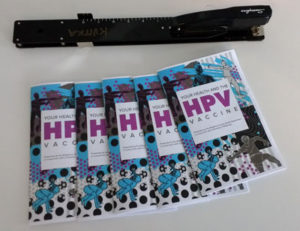
After considering several different printing options, we decided to print the pamphlets in a manner that could easily be duplicated by any university in-house.
We decided to present all of the materials to the Allegheny County Health Department in a mailing envelope similar to one that they may use when mailing toolkits to participating colleges.
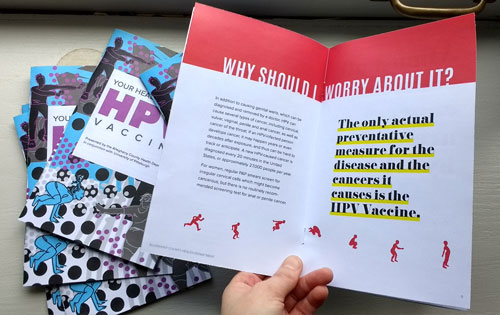
Several copies of the booklet, including one inside spread, to be given out during freshman orientation.
The final contents of the toolkit are as follows:
- Letter to school administrators
- Timeline of events (all three roleplayers: ACHD, University Administrators, and upperclass “Student Advocates”)
- Checklists for each roleplayer group to ensure easy planning and implementation
- Print-ready files:
9 posters, 3 for each Open House Day
16-page brochures to be given out at Freshman orientation or whenever appropriate
4 x 6” postcards with reminders of all Open House dates.
JPGs and GIFs for social media
Written content for websites and email reminders
Letter to student advocates
One sample pamphlet
One sample postcard
Style Guide, which includes colors and font face files.
Presentation
On December 16th, 2016, we introduced our research, methodology and the format of the Embrace Health HPV Campaign to our classmates, professors in the Design school, as well as our client Abby Wilson of ACHD.
Feedback
Although the presentation was not based around a critique, we received some questions and comments from our audience. These included curiosity about how we arrived at the visual system we’d developed, whether or not students who were younger than 18 would still need parental approval to receive the vaccine, and what insurance coverage is for college students. These and other questions gave us awareness of additional research we’d need to do to increase the feasibility and efficacy of the program.
Reflection/ Next Steps
Based on our research and given the low barriers to implementation, we feel Embrace Health will be an effective campaign to increase HPV vaccination rates on college campuses. It’s important to reach the college-age group before they pass the age limit for receiving the vaccine. Making vaccination easy on college campuses without appointments will help facilitate completing the recommended three doses.
If given the opportunity to explore further, we would research the potential impacts of health insurance on vaccine uptake on campus. In addition, we would do more personal interviews with freshmen and also with other student health centers at other universities to explore the level of interest among students and administration in the campaign.
…more personal interviews with freshmen and also with other student health centers at other universities to explore the level of interest among students and administration in the campaign.
Including information about the campaign in students’ acceptance packets for early introduction to the program is also worth consideration.
We are very interested in working with ACHD to further develop this campaign to help increase HPV vaccination rates among this important catch-up demographic. Recognizing the limited resource of the ACHD, working directly with colleges and universities to develop this program may also be worth consideration.

